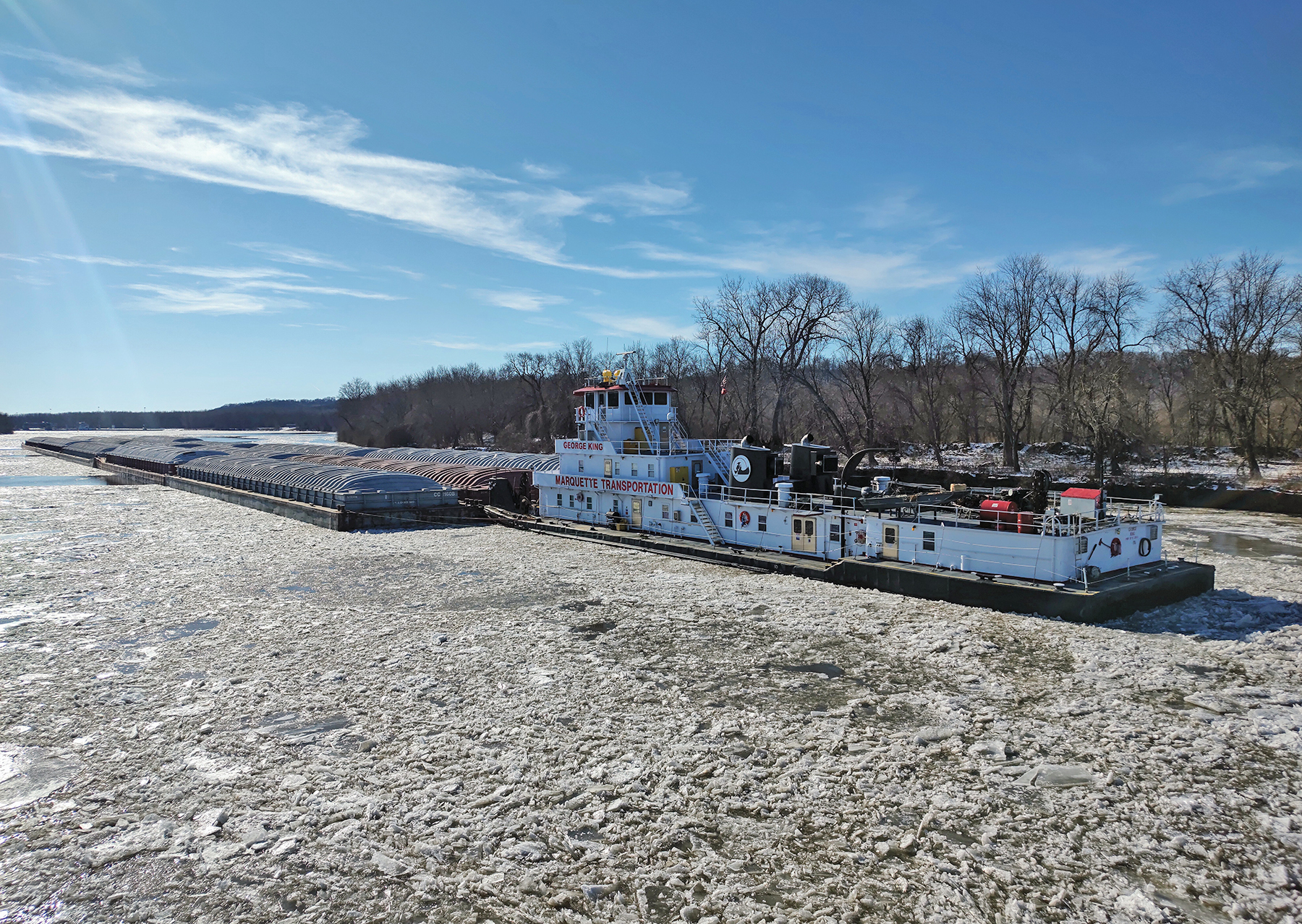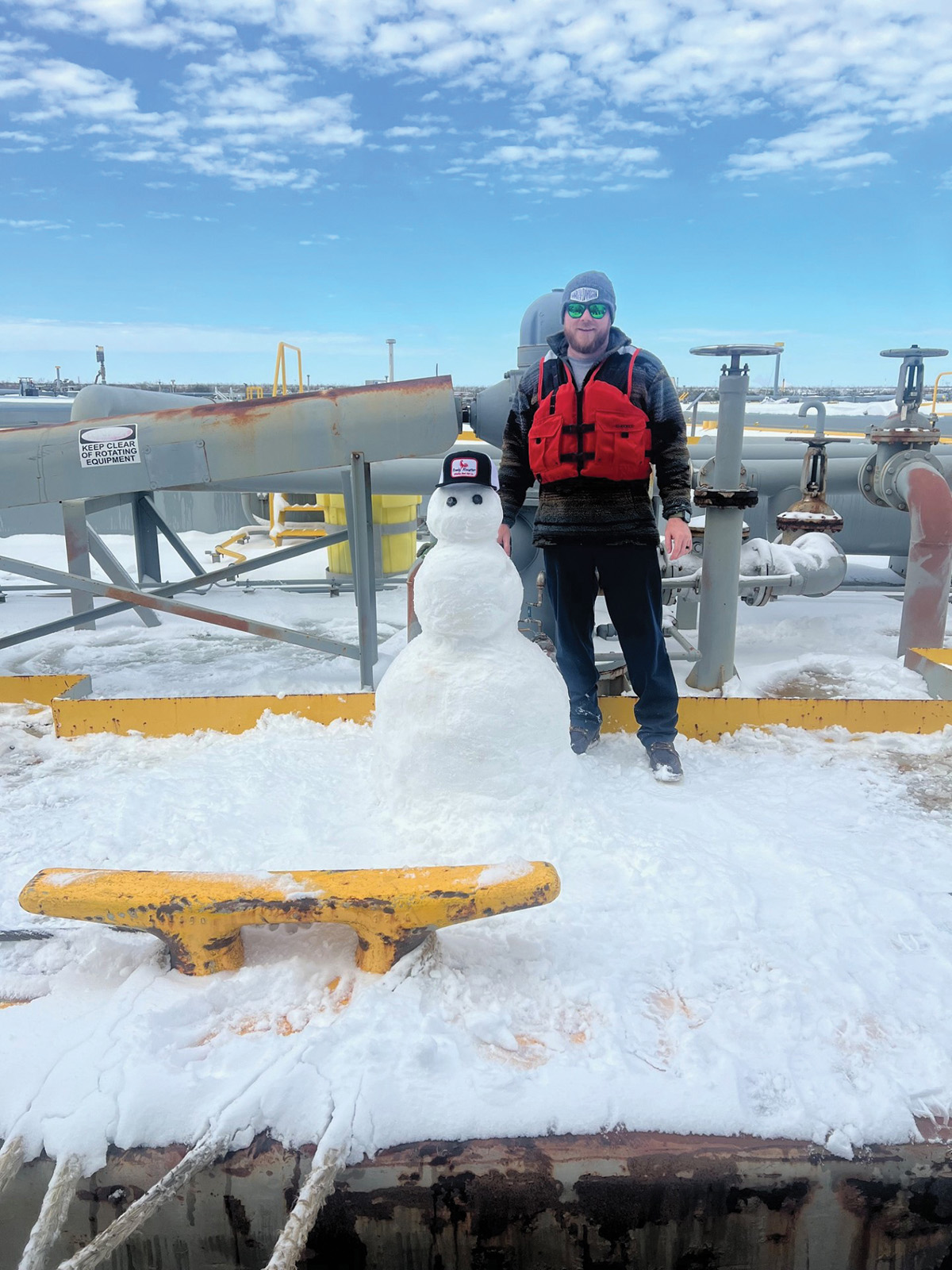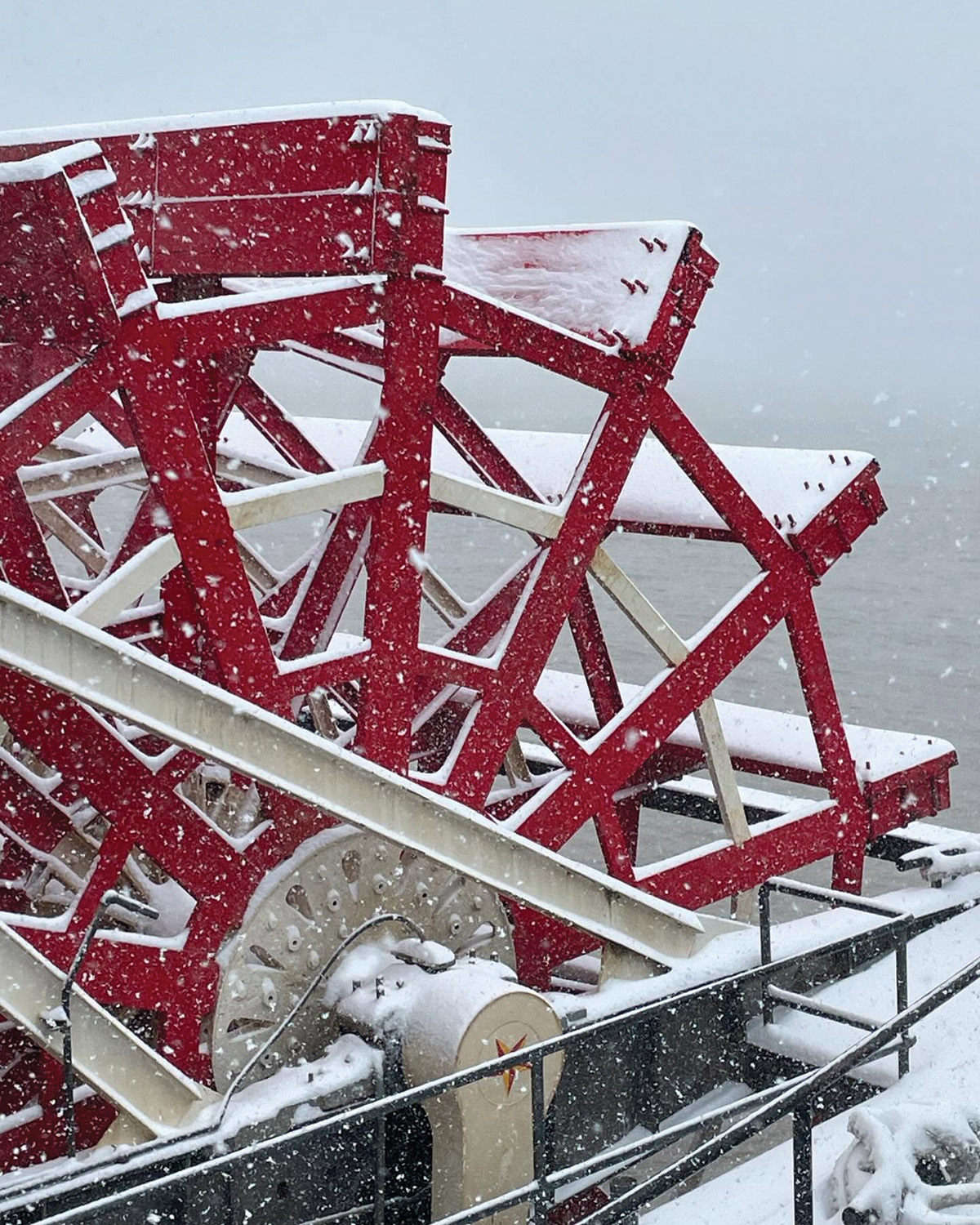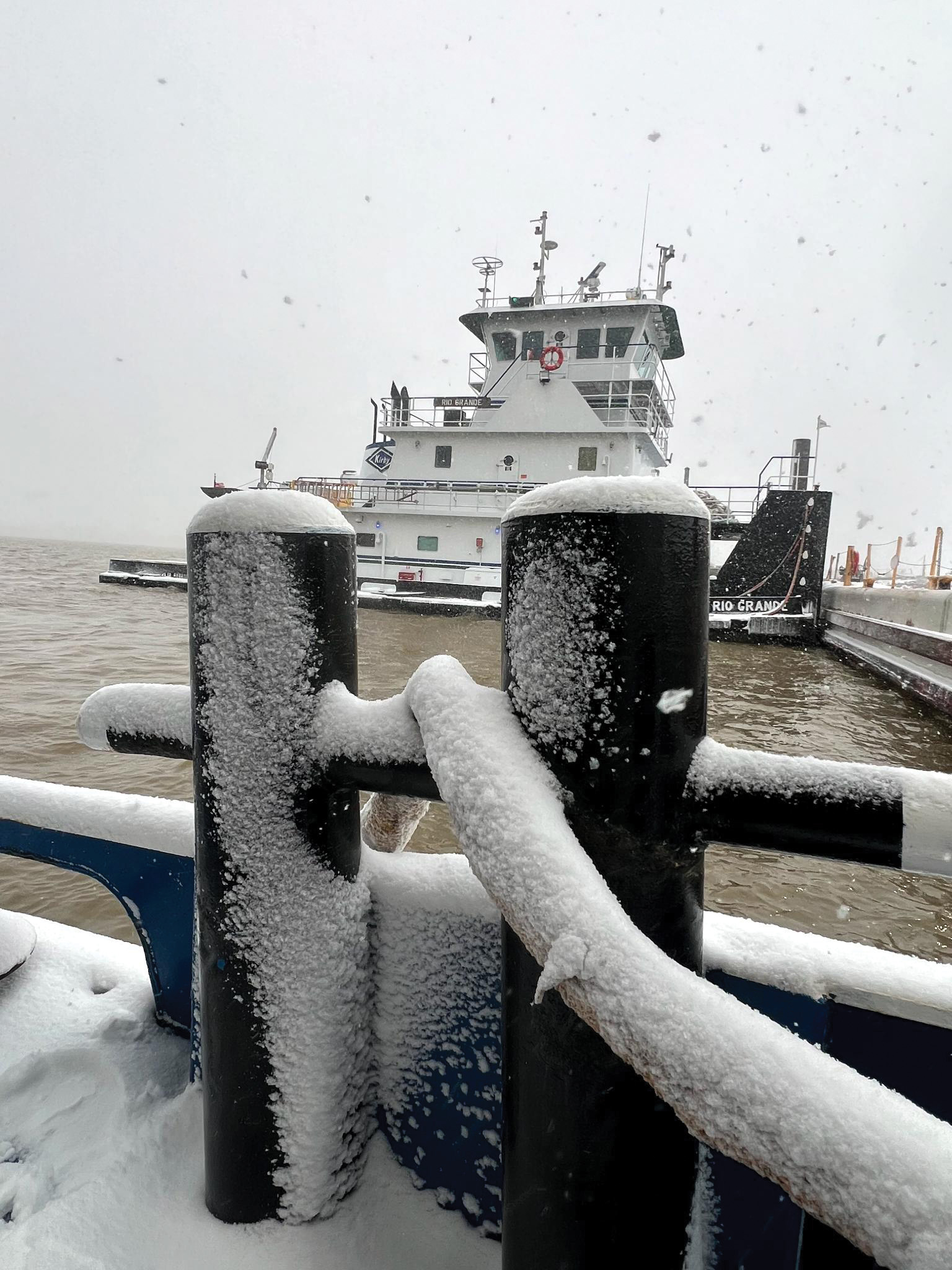Freezing temperatures, ice and snow are impacting navigation on the nation’s rivers, including a wide swath of the Southeast, which received record snowfall.
Pittsburgh Area
One of the worst hit areas appeared to be around Pittsburgh.
“It’s a very brutal winter,” said Shane Checkan, navigation committee chair for the Waterways Association of Pittsburgh and general manager of Industry Terminal and Salvage in Industry, Pa. “We haven’t seen the likes of this since 2018, and with the forecast we have, i don’t see much of a reprieve in it in the near future, to be honest.”
An arctic blast hit the region beginning January 19 and was continuing, with temperatures below zero at night and barely warming up past the single digits most days.
“Usually, you can have a cold night here or a cold night there or even a cold day, but when those string together consistently, that’s when it starts to get really bad for us,” Checkan said.
On January 22, the mv. Zephyr became stuck in the ice at Ohio River Mile 71.4, but it was able to be moved out of the channel and was being freed from the ice by an assist vessel, according to Petty Officer 3rd Class Anthony Randisi, a spokesman for the Coast Guard’s Eighth District.
The cold was causing problems both on land and on water, said Checkan, who reported “solid ice” from the Sewickley Bridge at Ohio River Mile 9 to Dashields Lock and Dam at Mile 13.3.
“There are not many boats moving up here other than some smaller tow sizes,” he said.
Some barges were moving on the Lower Monongahela River, also with scaled back tow sizes, but nothing was on the Allegheny.
“It’s so cold outside that some of the coal mines are shut down,” Checkan added. “They can’t run right now. Their rubber belts will freeze and break.”
Several terminals in the region had temporarily halted operations, he said.
Building tows had also become difficult and time-consuming, with ice having to be drifted out of every coupling.
“A lot of times it takes two boats to build tow in this kind of weather,” he said. “It adds costs, horsepower and time. It’s definitely very slow and very physically demanding.”
Checkan added that there had also been issues with frozen fuel lines on some loading and unloading equipment.
“The equipment is obviously meant to run in the winter, but when you start running sub-zero, everything starts breaking down,” he said. “It’s hard to operate.”
Mary Ann Bucci, executive director of the Port of Pittsburgh Commission, said she had been told of areas where the ice was 12 inches thick.
With reduced freight due to the closing of some area power plants, “You don’t have as much traffic moving on the rivers to break the ice up,” Bucci said.
Checkan said that at times, ice is refreezing so quickly after a tow passes that the broken ice stacks on top of existing solid ice, causing conditions to worsen. The industry was responding with multiple safety briefings, making sure crews had more opportunities to come in and warm up and ensuring they had the appropriate safety gear, including gloves, boots and vests, he added. Checkan said deck crews were also doing their best to keep barges free from ice in areas where the crews walk and do work.
“We’re fortunate to get good crews in this area, and they don’t get a lot of credit,” he said. “We can talk about safety and procedures, but they still have to be out there doing it.”
Illinois River
The Illinois River and its tributaries were experiencing heavy ice cover, with weather conditions favorable for river ice formation for the coming days, Scott Lincoln, senior service hydrologist at the National Weather Service’s Chicago/Rockford office, said in a briefing January 21 to the Illinois River Carriers’ Association.
“I don’t think the ice will be going anywhere quickly, at least not for the next week or so,” Lincoln said.
Doug Morgan, chief of locks for the Rock Island Engineer District, said the worst reach of the river was around LaGrange Lock and Dam, Illinois Mile 80.2.
Ice in that area was 3 to 4 inches thick with 90 percent ice coverage as of a January 23 update. Additionally, a problematic emptying valve had to be taken out of service at the lock, causing a queue to develop. Eight tows were waiting to lock through southbound and six northbound.
“It’s just a traffic jam down there,” Morgan said during the January 21 call, adding that industry assistance was needed for pulling southbound cuts, especially.
Terry Bass, chairman of the Illinois River Carriers’ Association, stressed the need for cooperation.
“If we can get guys on the lower end to pull cuts like we have on the upper end, it sounds like we could pull cuts and get everybody moving more quickly,” he said. “It’s a brotherhood, so we’ve got to help each other out.”
Those on the call quickly began coordinating which boats were in the area and available to help. They also stressed the importance of continued communication with the Corps to make sure they knew when and where help was needed most.
As of January 23, the Corps classified impacts as “significant” at LaGrange, Marseilles and Starved Rock pools. Width restrictions of 105 feet were in place at both Marseilles and Starved Rock, both of which had 100 percent ice coverage in the pools. The LaGrange and Dresden Island pools had 90 percent ice coverage. Peoria had 95 percent coverage. Ice thicknesses ranged from 3 to 6 inches in those pools.
Helper boats were being required both northbound and southbound at LaGrange, Marseilles and Starved Rock, with use of them on an as-needed basis at Dresden Island and Peoria.
In an industry call the afternoon of January 23, IRCA members discussed a plan in which a tow that had just locked through an area that required helper boats would pull a cut for the tow behind immediately behind it before moving on so as not to tie up tows at the lock for longer periods.
Ice couplings were being required throughout the waterway, and those tows without ice couplings could be bypassed during their turn to lock. The Coast Guard is also requested vessels transiting the Illinois River to contact the local lock and dam 30 minutes prior to arrival.
Southeast Snowstorm
On January 21, snow blanketed parts of southern Texas, Louisiana, Mississippi, Alabama and the Florida panhandle. From around 11 a.m. January 21 until after 8 p.m. that evening, the Coast Guard shut down the Mississippi River at Algiers Point due to lack of visibility.
The National Weather Service reported that an area from Houston into Alabama received a widespread 3 to 6 inches of snow, with some higher amounts locally. According to the National Weather Service, portions of New Orleans received 10 inches of snow, which tied a record set in 1895. The Lake Charles area also experienced its first ever blizzard warning.
Several other snow records were set around the Gulf Coast, including in Houston, Mobile, Ala., and Pensacola, Fla. Florida Gov. Ron DeSantis declared a state of emergency before the storm, with winter storm warnings spanning the area between Pensacola and Jacksonville.
Traffic on the Gulf Intracoastal Waterway between Mile 551 and Mile 661 (west of Harvey Lock) closed at 9 p.m. January 21 due to the water temperature dropping below 42.6 degrees Fahrenheit. Paul Dittman, president of the Gulf Intracoastal Canal Association (GICA), said the closure was due to a sea turtle cold stunning event, which takes place when the water temperature in the canal falls below 42.6 degrees.
“They float to the surface and are unable to move,” Dittman said.
GICA coordinates cold stunning event closures with Texas A&M University and the Texas Parks & Wildlife Department. The closure was scheduled to end at 6 p.m. January 23.
Moveable bridges across the waterway experienced closures to marine traffic due to ice accumulations, Dittman said. All but one of those had reopened at press time. Elsewhere on the waterway, no formal closures had been announced, Dittman said, though the weather nonetheless largely brought traffic to a standstill for a couple of days.
“We certainly do not see icy conditions of this magnitude down here very often,” Dittman said.
————
Featured photo caption: Marquette Transportation Company’s mv. George King at Illinois River Mile 80, waiting its turn to lock down at LaGrange Lock and Dam on January 16. (Photo by Capt. John Vaughn, courtesy of We Work The Waterways.)







